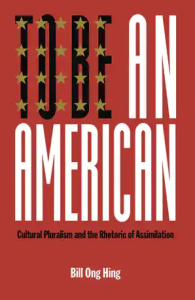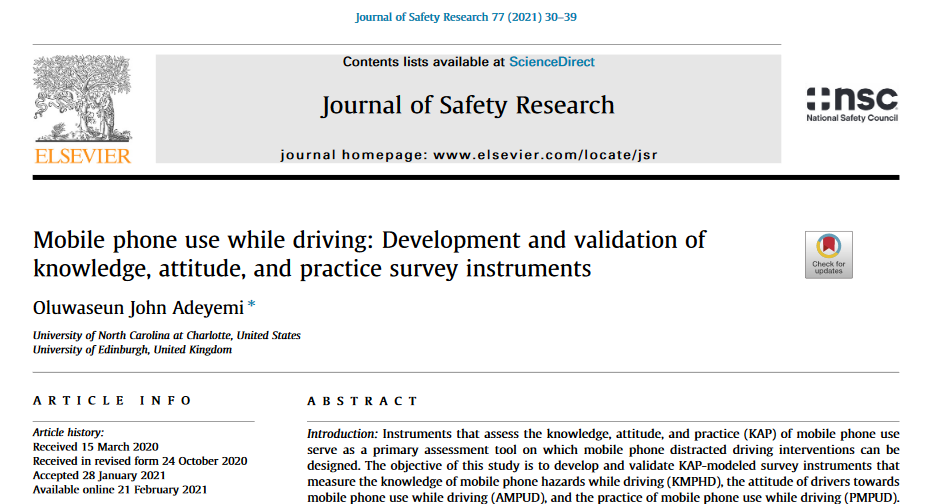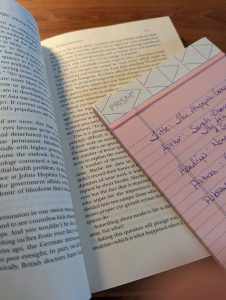Using Pre-Reading Strategies
Academic reading is not like reading a novel. You aren’t starting at the beginning and looking forward to being surprised and delighted as you turn the page. And you certainly aren’t going to wait until the last chapter to know how it ends, like you would with a mystery. You want to understand as much as you can about the reading right from the beginning so that you can read efficiently.
This is called “pre-reading” or sometimes “previewing.” When you pre-read a text, you’ll turn into a temporary sleuth, examining the text for clues as to its meaning.
Start with the Title
A good title will inform you about the text’s content. Titles can also be interesting, catchy, or clever, but the most important job of a title is to let the reader know what the text will be about.
For instance, imagine you’re reading a magazine article entitled “Three Hundred Sixty-five Properly Poofy Days.” Reading that title, do you have any idea what this article is going to be about?
- It could be written by a meteorologist, reporting on a year of observing cloud formations.
- It might be a biopic (a biographical story) about an eccentric salon that specializes in “big hair” dos.
- Perhaps it’s a set of guidelines for using poofy cotton balls to apply cosmetics.
- Or it could be a story about a dog groomer who grooms poodles, the poofiest of dogs.
This title doesn’t give enough information about the content of the text. Keep this in mind when you are writing your own titles!
Take a look at the important words in the title, usually the nouns. Those words should tell you about the content of the article. If you aren’t familiar with a word in the title, this is a good time to look it up (and make a note of the definition). That word will almost certainly be important in your understanding of the reading.
Sometimes, you will see titles with two parts. In books and magazine articles, a second title often appears in smaller and sometimes different font under the main title. The second title is called a “subtitle,” and it’s usually more informative than the main title. In academic research articles, also known as scholarly articles, these titles usually follow the main title after a colon.

Let’s look at a couple of two-part titles.
In the case of the image on the right, the main title, To Be an American, could mean quite a few different things, but the phrases “cultural pluralism” and “rhetoric of assimilation” give us a hint that the book will be about how and whether minority communities maintain their own cultures or assimilate. If you read the description of the book, you’ll see that this one focuses specifically on immigrants, a point which isn’t clear from the title, though it is implied a bit in the idea of the main title about being American. This is an example of a title that could be a bit clearer to help readers understand the focus of the book.
Article titles also use subtitles, though this is much more common in scholarly articles than in popular articles. The first part of the title “Mobile Phone Use While Driving” (below) leads us to believe that the article will focus on something about using phones while we drive, but the subtitle tells us that the article will be about the surveys that gather information about mobile phone use.

When you use two-part titles in your academic writing, you will usually separate them with a colon. The example book title, for instance, would be typed To Be an American: Cultural Pluralism and the Rhetoric of Assimilation (italicized because it’s a book).
You would not use a colon if another piece of punctuation separates the two parts. For example, in the article titled “Attention or Distraction? The Impact of Mobile Phone on Users’ Psychological Well-Being” by Chu et al., you don’t change the question mark to a colon, nor do you add a colon (and the title is in quotation marks because it’s an article).
Be aware that the specifics about which words get capitalized and when varies a bit by style guide.
Identify the Author’s Expertise
Have you heard of the author? Even if you haven’t, sometimes you’ll find a short bio about the author at the beginning or end of a text. You can always search the internet to look for more details.
Ideally, the author should be an acknowledged expert on the subject or should have degrees, training, or credentials that make them an expert. Particularly if you are going to be writing about the text, you might want to make some notes about the author so that you can include information about their expertise in your own writing.
When there are two or three authors, you should take a look at the credentials of all of them. Sometimes, however, such as in scientific studies, you will see a long list of authors. When this happens, it’s generally enough to look at the credentials of the first author, who is usually the lead researcher of the group. But keep in mind that these texts are not just written by that first author. When you write about these texts, you’ll need to refer to all of the authors. Check your style guide for how to do this.
Skim the Headings
Headings, if present, will often give you clues as to the text’s content. As with the main title, if there are words you don’t already know, take a moment to look them up and write the definition down in your annotations.
Headings will also show you how the text has been divided into sections. This includes chapter breaks and subsections within chapters and articles. Textbooks often number these subsections or use some kind of outlining structure.
Also pay attention to the typeface of the headings. Headings of the same size and font are all at the same level of importance. Compare, for example, the heading styles for this textbook with the structure in the table of contents.
Scan the Images and “Pull-Outs”
 Images—and their captions—will often give you valuable information about the topic. Images include photographs, charts, graphs, maps, and illustrations. While this is not (yet) the time to study those images, previewing them will help you understand what you are about to read.
Images—and their captions—will often give you valuable information about the topic. Images include photographs, charts, graphs, maps, and illustrations. While this is not (yet) the time to study those images, previewing them will help you understand what you are about to read.
Similarly, “pull-outs” (content that is pulled off to one side or highlighted in a box) will tell you a bit about information that the author considered interesting or important but ultimately peripheral to the main text. This supplementary content can give you clues about the main ideas. Again, you’re not reading these carefully yet—just taking a quick look to get an overview of the text.
Check the Publication Date
When was this text written? While this won’t necessarily help you preview the contents of the text, it will give you a sense of what else was going on at the time this text was written. This can also help you think about whether there have been significant events since the publication date that might influence current thinking on the subject. For example, think about the ways in which a book about wildfires written in 1995 might differ from one written in 2020.
Using Your Preview
After working through these strategies, make note of the central idea or argument you believe the text to be about. Then, as you read, you’ll be able to use this knowledge to guide your understanding of the details in the text.
This seems like a lot, but it generally only takes a few minutes, especially once you practice the skills. Pre-reading will save you lots of time and frustration because you’ll already have a general understanding of the text before you start reading.
Details of the previewing work
Let’s go back to the sample assignment and preview Mitchell’s article:
- Title—The complete title is “The First Battle in the Culture Wars: The Quality of Diversity.”
- The first part tells me that Mitchell is going to discuss the “culture wars,” and when I look this up, I see that these are conflicts between cultures about which one is going to be dominant. Given the picture that appears in the original publication of this article, I’m assuming he’s talking about racial conflict in the United States. I wonder why he’s talking about a “first” battle, though, since that war has been going on for a long time.
- This subtitle tells me that Mitchell is going to talk about diversity, but he is using the phrase “quality of diversity.” When I try searching for that phrase, I don’t get much. I know generally what diversity is, so I look up “quality” just to try to find a definition that fits here. I find two that might fit: a standard for how something is measured or a distinctive characteristic.
- Author—The author is Nicholas Ensley Mitchell. Near the top of the article, there is a link and his title. He’s an assistant professor of curriculum studies at the University of Kansas. When I click on the link, I find out that he has a Ph.D. from Louisiana State University, that he has worked as a policy and research fellow at Loyola University, and that he researches the ways in which race appears in school curricula. This article doesn’t appear to be about school curricula (at least not so far), but it is about race relations.
- Headings—There are two headings in this article: “Segregated Coexistence” and “Living in Community.” “Segregated coexistence” sounds like people living near each other without integrating. They get along mostly by ignoring each other. “Living in community” sounds like something a minister would say, meaning living together in ways that are connected. Without reading the article, I don’t really know if this is what Mitchell means, but these are central ideas in the text, since they each get their own heading.
- Pictures and Pullouts—There are two pictures with the original publication of this article.
- The first shows mostly Black people walking with arms linked. The printing on some of their shirts indicate that they are protesting restrictions on voting rights, and the caption says that this is what they were doing in Washington, D.C. on July 15, 2021. This reinforces my sense that Mitchell is focusing on Black equity issues in the U.S.
- The second shows protesters arguing across a police line. The caption tells me that one is a white supremacist and the other is a Black man, and the picture was taken in New York City on September 3, 2020. This picture echoes the use of “war” in the title of the article.
- There are no pull-outs in this article.
- Publication Date—This article was published on October 14, 2021. This is pretty recent, and issues like voting rights and how voting restrictions hurt minorities were in the news at that time. Around the same time, particularly with the COVID pandemic, there was a lot of discussion about racial disparities and how so many Blacks are killed by police (and others). There was (and still is, as of this writing) a lot of tension around race in the U.S. at this time.
Going into this reading, I know that the article will deal with race relations in the United States. Because of the assignment, I know that I need to focus most on what Mitchell means by “the quality of diversity,” “segregated coexistence,” and “living in community.”
It took me much longer to write this preview up than it did to do the actual previewing. Pre-reading this article took less than five minutes. Writing this up took about thirty.
Now it’s your turn. Choose one of the three articles from the sample assignment (or another reading you are working on) and preview that article. In fact, pre-reading can be so quick that you can use it as a way to figure out which article you want to use. Be sure to look at the features I’ve discussed in this section:
- The title
- The author’s expertise
- The headings
- The images and pull-outs
- The publication date
After you have looked at all of these features, make some notes for yourself about what you think the article is going to be about and what questions you have for when you start reading.
Reflection After Reading: After you have finished reading the article, reflect on how useful this pre-reading was in helping you understand the article. What parts were most helpful? What weren’t particularly helpful? What would you change the next time you have a reading to preview?
Key Points: Using Pre-Reading Strategies
- Pre-reading (also called previewing) saves you time and makes your reading more effective.
- Start with the title and author, but also look at any headings, images, and pull-outs.
- The date of publication can help you think about what else was going on at the time.
Text Attribution
This chapter contains material taken from the chapter “Using Pre-reading Strategies” from The Word on College Reading and Writing by Carol Burnell, Jaime Wood, Monique Babin, Susan Pesznecker, and Nicole Rosevear and is used under a CC BY-NC 4.0 license.

